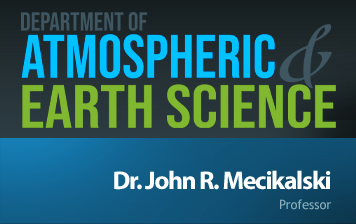Satellite-based Convective Storm & Convective Initiation Studies
Lightning Cessation Research
 Background:
Background:
This aspect of work aims to examine the dual-polarimetric radar characteristics when lightning cessation procedure occurs. The dual-polarimetric radar observations collected by the Advanced Radar for Meteorological and Operational Research (ARMOR) were analyzed to indicate the cloud and precipitation structure of the storm. The North Alabama Lighting Mapping Array (NALMA) data was analyzed for the lightning activities.
Main Results:
The dissipation stage of lightning activity for each individual cells were examined. The ARMOR dual-pol variables for each cell at the corresponding time were also analyzed. Figure 1 shows the time series of lightning sources between 1700 UTC and 1800 UTC and ARMOR products for the 1st cell of the thunderstorm on 11 April 2008.
Many field observations suggest that a strong updraft in the mixed phase layer (0 to -40 ºC) is necessary to produce lightning. It is generally believed that the non-inductive charging (Reynolds et al. 1957; Mansell et al. 2005) generates most of the thunderstorm electrification in the mixed phase layer. Non-inductive charging involves rebounding collisions between graupel and ice crystals in the presence of supercooled liquid water. Strong updrafts drive the generation of graupel and ice crystals, enhances particle collision frequencies at updraft boundaries, and enables the charge separation on a cloud scale. Zipser and Lutz (1994) suggested that strong updraft with a mean of 6 m/s is required to facilitate cloud electric field to initiate lightning. Blyth et al. (2001) indicated that the updraft speed is roughly linearly related to the lightning frequency. Boccippio (2002) predict a relationship between total lightning frequency and updraft speed to the power of 2 or higher and a relationship between total lightning frequency and storm length scale to the power of 5. Tessendorf et al. (2005) found good correlation between the volume of updraft exceeding 10 m/s and total lightning activity. Deierling and Petersen (2008) indicated that the updraft volume above -5 ºC level with w exceeding 5 and 10 m/s is well correlated (correlation coefficient of 0.93 and 0.92, respectively) to mean total lightning activity.
Based on the cases we have examined so far, when the last flashes occurred, the mass of precipitation ice was commonly at the bottom of a decreasing trend with a value in the order of 100 x 109 g when integrated from the -5 ºC level and 10-1 x 109 g when integrated from the -10 ºC level. The mass of precipitation ice shows a close relationship with lightning source density. The vertical velocity could also have a large contribution for the lightning cessation. Our future and ongoing work would include three components. Firstly, more cases will be chosen to examine for the threshold values of the radar variables when the last flashes occur. Moreover, more cases will be chosen to examine in detail the difference in the kinematic structure for different weather regimes before and after the occurrence of the last flashes. Thirdly, more parameters in the dual-polarimetric radar variables should be extracted to study the characteristics of lightning cessation.

